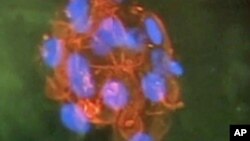Scientists say they have been able to transform human stem cells into functioning lung and airway cells in what they’re calling a first.
The results could eventually lead to growing lung material that could be transplanted with a much smaller chance of rejection.
“Researchers have had relative success in turning human stem cells into heart cells, pancreatic beta cells, intestinal cells, liver cells, and nerve cells, raising all sorts of possibilities for regenerative medicine,” said study leader Hans-Willem Snoeck, MD, PhD, of the Columbia University Medical Center.
Snoeck added that lung transplants ”have a particularly poor prognosis.”
“Although any clinical application is still many years away, we can begin thinking about making autologous lung transplants—that is, transplants that use a patient’s own skin cells to generate functional lung tissue,” he said.
In 2011, Snoeck discovered a set of chemical factors that allowed the transformation of human embryonic stem into precursors of lung and airway cells.
In the current study, Dr. Snoeck and his colleagues found new factors that can complete the transformation of human ES or iPS cells into functional lung epithelial cells (cells that cover the lung surface).
Of particular importance is that the cells produce surfactant, a substance critical to maintaining the lung alveoli, where gas exchange takes place; they also participate in repair of the lung after injury and damage.
The findings have implications for the study of a number of lung diseases, including idiopathic pulmonary fibrosis.
“No one knows what causes the disease, and there’s no way to treat it,” said Snoeck. “Using this technology, researchers will finally be able to create laboratory models of IPF, study the disease at the molecular level, and screen drugs for possible treatments or cures.”
Snoeck said that in the longer term, the development could lead the ability to make a make an autologous lung graft.
“This would entail taking a lung from a donor; removing all the lung cells, leaving only the lung scaffold; and seeding the scaffold with new lung cells derived from the patient,” he said. “In this way, rejection problems could be avoided.”
The study, entitled “Highly efficient generation of airway and lung epithelial cells from human pluripotent stem cells,” was published today in the journal Nature Biotechnology.
The results could eventually lead to growing lung material that could be transplanted with a much smaller chance of rejection.
“Researchers have had relative success in turning human stem cells into heart cells, pancreatic beta cells, intestinal cells, liver cells, and nerve cells, raising all sorts of possibilities for regenerative medicine,” said study leader Hans-Willem Snoeck, MD, PhD, of the Columbia University Medical Center.
Snoeck added that lung transplants ”have a particularly poor prognosis.”
“Although any clinical application is still many years away, we can begin thinking about making autologous lung transplants—that is, transplants that use a patient’s own skin cells to generate functional lung tissue,” he said.
In 2011, Snoeck discovered a set of chemical factors that allowed the transformation of human embryonic stem into precursors of lung and airway cells.
In the current study, Dr. Snoeck and his colleagues found new factors that can complete the transformation of human ES or iPS cells into functional lung epithelial cells (cells that cover the lung surface).
Of particular importance is that the cells produce surfactant, a substance critical to maintaining the lung alveoli, where gas exchange takes place; they also participate in repair of the lung after injury and damage.
The findings have implications for the study of a number of lung diseases, including idiopathic pulmonary fibrosis.
“No one knows what causes the disease, and there’s no way to treat it,” said Snoeck. “Using this technology, researchers will finally be able to create laboratory models of IPF, study the disease at the molecular level, and screen drugs for possible treatments or cures.”
Snoeck said that in the longer term, the development could lead the ability to make a make an autologous lung graft.
“This would entail taking a lung from a donor; removing all the lung cells, leaving only the lung scaffold; and seeding the scaffold with new lung cells derived from the patient,” he said. “In this way, rejection problems could be avoided.”
The study, entitled “Highly efficient generation of airway and lung epithelial cells from human pluripotent stem cells,” was published today in the journal Nature Biotechnology.







